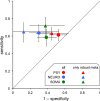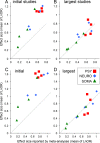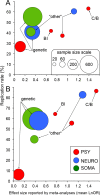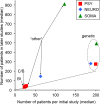Replication Validity of Initial Association Studies: A Comparison between Psychiatry, Neurology and Four Somatic Diseases - PubMed (original) (raw)
Meta-Analysis
Replication Validity of Initial Association Studies: A Comparison between Psychiatry, Neurology and Four Somatic Diseases
Estelle Dumas-Mallet et al. PLoS One. 2016.
Abstract
Context: There are growing concerns about effect size inflation and replication validity of association studies, but few observational investigations have explored the extent of these problems.
Objective: Using meta-analyses to measure the reliability of initial studies and explore whether this varies across biomedical domains and study types (cognitive/behavioral, brain imaging, genetic and "others").
Methods: We analyzed 663 meta-analyses describing associations between markers or risk factors and 12 pathologies within three biomedical domains (psychiatry, neurology and four somatic diseases). We collected the effect size, sample size, publication year and Impact Factor of initial studies, largest studies (i.e., with the largest sample size) and the corresponding meta-analyses. Initial studies were considered as replicated if they were in nominal agreement with meta-analyses and if their effect size inflation was below 100%.
Results: Nominal agreement between initial studies and meta-analyses regarding the presence of a significant effect was not better than chance in psychiatry, whereas it was somewhat better in neurology and somatic diseases. Whereas effect sizes reported by largest studies and meta-analyses were similar, most of those reported by initial studies were inflated. Among the 256 initial studies reporting a significant effect (p<0.05) and paired with significant meta-analyses, 97 effect sizes were inflated by more than 100%. Nominal agreement and effect size inflation varied with the biomedical domain and study type. Indeed, the replication rate of initial studies reporting a significant effect ranged from 6.3% for genetic studies in psychiatry to 86.4% for cognitive/behavioral studies. Comparison between eight subgroups shows that replication rate decreases with sample size and "true" effect size. We observed no evidence of association between replication rate and publication year or Impact Factor.
Conclusion: The differences in reliability between biological psychiatry, neurology and somatic diseases suggest that there is room for improvement, at least in some subdomains.
Conflict of interest statement
Competing Interests: The authors have declared that no competing interests exist.
Figures
Fig 1. ROC diagram expressing the sensitivity and specificity of initial studies in agreeing with corresponding meta-analyses regarding the presence or absence of a nominally significant effect.
For the three biomedical domains the diagram either considered all 663 pairs of initial studies and meta-analyses (circles) or only the 385 initial studies paired with stringent meta-analyses (triangles). Error bars represent the confidence intervals at 95%. The dashed diagonal line corresponds to no discrimination above chance. The fact that errors bars related to psychiatry cross this line suggests that the agreement between initial studies and corresponding meta-analyses might not be better than chance. PSY: psychiatry; NEURO: neurology; SOMA: somatic diseases.
Fig 2. Comparison between effect sizes reported by initial or largest studies and their corresponding meta-analyses.
All effect sizes were expressed as LnOR (standardized mean differences were converted to LnOR as described in the Methods). (A) and (C) Mean of the effect sizes reported by initial studies for each pathology. (B) and (D) Mean of the effect sizes reported by largest studies for each pathology. (A) and (B) All 663 trios were considered. (C) and (D) Only the 359 initial studies reporting a significant effect and their corresponding largest studies. The dashed lines correspond to equality between the effect sizes of the initial studies or of the largest studies and the effect sizes reported by the meta-analyses. PSY: psychiatry; NEURO: neurology; SOMA: somatic diseases.
Fig 3. Replication rate of initial studies depending on the “true” effect and on the sample size.
The replication rate was calculated for the eight subgroups as the percentage of initial studies that were consistent with meta-analyses and whose effect size inflation was ≤100% (raw data are given in Tables 5 and 6). The average of the “true” effect size was the mean of the summary effect size reported by each stringent meta-analysis for each subgroup. The sample size corresponded to the median of the number of patients of all initial studies in each subgroup and was represented as the area of the circles (same scale for (A) and (B)). (A) All initial studies paired with stringent meta-analyses (n = 382). (B) Only initial studies reporting a significant effect and paired with stringent meta-analyses (n = 232). BI: brain imaging studies; C/B: cognitive/behavioral studies; PSY: psychiatric disorders; NEURO: neurological diseases; SOMA: somatic diseases.
Fig 4. Relationship between the number of patients in initial studies and the average number of patients in subsequent studies.
The average number of patients in subsequent studies was calculated by subtracting the number of patients in initial studies from the total number of patients included in each meta-analysis and by dividing it by the number of datasets minus one. The 659 averaged sample sizes of subsequent studies were sorted in eight subgroups and we calculated the median for each subgroup. These eight medians were plotted as a function of the medians of the number of patients in initial studies for each subgroups. The dashed line corresponds to equality between both median types. BI: brain imaging studies; C/B: cognitive/behavioral studies.
Similar articles
- Poor replication validity of biomedical association studies reported by newspapers.
Dumas-Mallet E, Smith A, Boraud T, Gonon F. Dumas-Mallet E, et al. PLoS One. 2017 Feb 21;12(2):e0172650. doi: 10.1371/journal.pone.0172650. eCollection 2017. PLoS One. 2017. PMID: 28222122 Free PMC article. - Evidence of reporting biases in voxel-based morphometry (VBM) studies of psychiatric and neurological disorders.
Fusar-Poli P, Radua J, Frascarelli M, Mechelli A, Borgwardt S, Di Fabio F, Biondi M, Ioannidis JP, David SP. Fusar-Poli P, et al. Hum Brain Mapp. 2014 Jul;35(7):3052-65. doi: 10.1002/hbm.22384. Epub 2013 Oct 7. Hum Brain Mapp. 2014. PMID: 24123491 Free PMC article. - Bias in Peripheral Depression Biomarkers.
Carvalho AF, Köhler CA, Brunoni AR, Miskowiak KW, Herrmann N, Lanctôt KL, Hyphantis TN, Quevedo J, Fernandes BS, Berk M. Carvalho AF, et al. Psychother Psychosom. 2016;85(2):81-90. doi: 10.1159/000441457. Epub 2016 Jan 26. Psychother Psychosom. 2016. PMID: 26808272 Review. - Comparison of effect sizes associated with biomarkers reported in highly cited individual articles and in subsequent meta-analyses.
Ioannidis JP, Panagiotou OA. Ioannidis JP, et al. JAMA. 2011 Jun 1;305(21):2200-10. doi: 10.1001/jama.2011.713. JAMA. 2011. PMID: 21632484 - Association of traumatic brain injury with subsequent neurological and psychiatric disease: a meta-analysis.
Perry DC, Sturm VE, Peterson MJ, Pieper CF, Bullock T, Boeve BF, Miller BL, Guskiewicz KM, Berger MS, Kramer JH, Welsh-Bohmer KA. Perry DC, et al. J Neurosurg. 2016 Feb;124(2):511-26. doi: 10.3171/2015.2.JNS14503. Epub 2015 Aug 28. J Neurosurg. 2016. PMID: 26315003 Free PMC article. Review.
Cited by
- Messaging in Biological Psychiatry: Misrepresentations, Their Causes, and Potential Consequences.
Dumas-Mallet E, Gonon F. Dumas-Mallet E, et al. Harv Rev Psychiatry. 2020 Nov/Dec;28(6):395-403. doi: 10.1097/HRP.0000000000000276. Harv Rev Psychiatry. 2020. PMID: 33156157 Free PMC article. Review. - Understanding and Mitigating the Replication Crisis, for Environmental Epidemiologists.
Bartell SM. Bartell SM. Curr Environ Health Rep. 2019 Mar;6(1):8-15. doi: 10.1007/s40572-019-0225-4. Curr Environ Health Rep. 2019. PMID: 30671781 Review. - Current Incentives for Scientists Lead to Underpowered Studies with Erroneous Conclusions.
Higginson AD, Munafò MR. Higginson AD, et al. PLoS Biol. 2016 Nov 10;14(11):e2000995. doi: 10.1371/journal.pbio.2000995. eCollection 2016 Nov. PLoS Biol. 2016. PMID: 27832072 Free PMC article. - Poor replication validity of biomedical association studies reported by newspapers.
Dumas-Mallet E, Smith A, Boraud T, Gonon F. Dumas-Mallet E, et al. PLoS One. 2017 Feb 21;12(2):e0172650. doi: 10.1371/journal.pone.0172650. eCollection 2017. PLoS One. 2017. PMID: 28222122 Free PMC article. - Effect size, sample size and power of forced swim test assays in mice: Guidelines for investigators to optimize reproducibility.
Smalheiser NR, Graetz EE, Yu Z, Wang J. Smalheiser NR, et al. PLoS One. 2021 Feb 24;16(2):e0243668. doi: 10.1371/journal.pone.0243668. eCollection 2021. PLoS One. 2021. PMID: 33626103 Free PMC article.
References
Publication types
MeSH terms
Substances
LinkOut - more resources
Full Text Sources
Other Literature Sources



